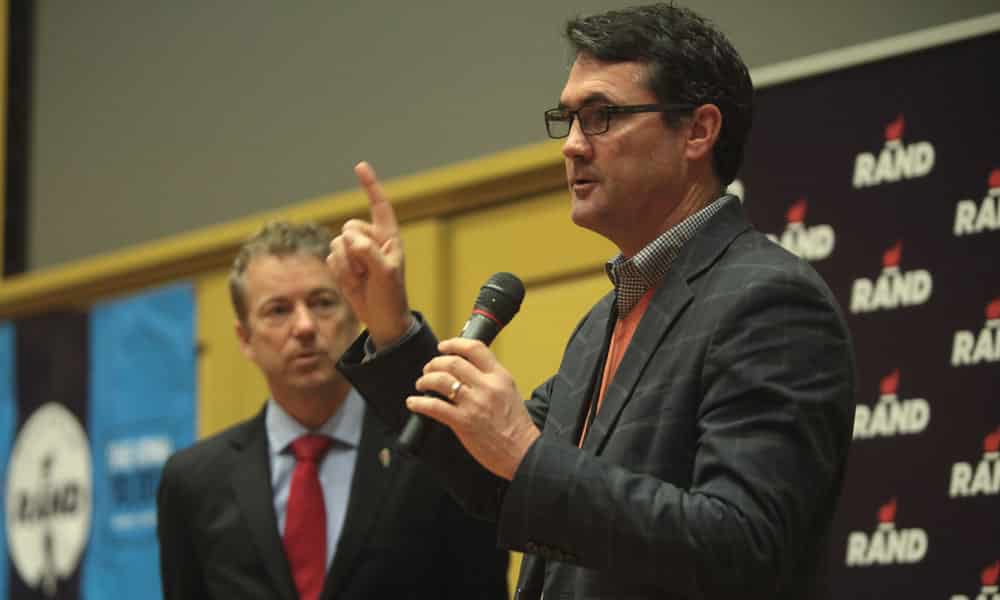Stop Stealing My Sign
Yard signs are everywhere during political campaigns, but campaign organizers don't think they actually work. So why do campaigns spend so much on them?
Hey all, Ernie here with a refreshed classic of a piece, originally from 2016, about the history and legacy of the political yard sign. With Super Tuesday just weeks away in the U.S., things are starting to get serious, which means it’s a good time to talk yard signs.
Sponsored By Future London Academy
Learn Innovation from McKinsey, Ogilvy, Deliveroo and Futurice. Join a 5-day immersive design thinking safari in London. Talks, workshops, office visits, fireside chats and networking. Explore the latest service design frameworks, research tools, corporate accelerators and data ethics. Only 30 participants, all senior professionals from around the world. Book your place now
$3.07
The cost, per sign, to purchase 2,000 full-color, double-sided yard signs from the website Dirt Cheap Signs, a price that includes metal H-stakes to embed the signs into the ground. (The full cost of the sign buy is $6,140.) Purchasing yard signs is a game of scale—buying just one doesn’t make a lot of sense, but buying thousands or tens of thousands is relatively cost-effective. In comparison, it costs a few hundred dollars to run a single local television ad, according to Entrepreneur. But, on the other hand, there’s a lot less physical labor that goes into a televised campaign ad—you don’t have to shove 2,000 printed signs into the ground.

How a shaving cream company helped inspire the rise of the yard sign
In October of 2008,The Onion made a spot-on joke about political campaigning at John McCain’s expense. The headline, “McCain Blasts Obama As Out Of Touch In Burma-Shave-Style Billboard Campaign,” suggested that the Republican candidate was using road signs as anti-Obama poetry, in a style similar to the shaving company’s long-running campaign, that lasted through the 1960s.
The joke—that McCain was relying on outdated marketing methods to campaign at a time when Obama was basically inventing the “big data” campaign—was worth a chuckle or ten. But hidden in the satire is a grain of truth. Burma-Shave did inspire political campaigning, because it highlighted just how effective signage could be in the right context.
The company, which had brought one of the first brushless shaving creams to the market, was struggling to reach its target audience, until Alan Odell, the son of the company’s owner, one day suggested making roadside signs that advertised the company. He was given a couple of hundred dollars to try the idea out, putting the signs out in a remote part of Minnesota. Almost immediately, the sing-song ads had an effect on the company’s bottom line, and for the next 40 years, Burma-Shave was a constant on major roadways.
The interstate era ultimately did Burma-Shave in, forcing a change in tactics after the company was sold off. But the campaign helped to show the value of small-scale signage, which ultimately has become a key element in modern political campaigns, Onion jokes aside.
And there’s even direct evidence that Burma-Shave had a direct effect on political campaigning. In Canada, the company directly inspired a political term, “burma-shaving,” which basically means that a candidate holds out one of their signs and shows off to passers-by, effectively creating a natural photo-op.
Jim Flaherty, Canada’s late finance minister, once recalled during a commencement speech at the University of Western Ontario having to do this on election day in 2008.
“While I don’t know if this technique actually gets you votes, I do know that it keeps nervous candidates busy and not bothering their campaign team, the ones doing the real work,” Flaherty noted in his speech.
1.7%
The increase in voter share attributed to yard signs, according to a Columbia University study. The researchers told Politico in 2015 that they were surprised by the modest finding—because they assumed the study would show that the signs had no effect at all. “We were surprised by these findings, because the conventional wisdom is that lawn signs don’t do much—they’re supposed to be a waste of money and time. Many campaign consultants think that signs ‘preach to the choir’ and not much else,” co-author Alex Coppock told the website. Still, 1.7 percent is not much to write home about—unless you’re running a tight race.
/uploads/0220_yang.jpg)
Five people who wrote letters to the editor about stolen yard signs
- “Campaign signs don’t vote. However, the people whose signs were stolen do vote, and do tell their friends and neighbors.”
- “To the person or people who are stealing the Bill Brown for Commissioner yard signs from Carroll County homes, this just proves you can face the competition.”
- “If the thief or thieves wanted the signs, why didn’t you come to ask me for them face to face? Cowardly actions.”
- “Upon discovering this morning that a political yard sign was gone from our yard, I first wondered how a major network news anchor might have reported it.”
- “By stealing our yard signs, you are taking away our freedom of speech. Just a note—we’ve noticed Democrat campaign signs are still up down the road from us.”

Steve Grubbs, right, with Rand Paul. (Gage Skidmore/Flickr)
The guy who has changed the game for political signage
When most people think about political signs, they generally think about them in terms of the rectangular 18"x24" setup that has become the standard-bearer in yards around the country.
Steve Grubbs, however, doesn’t think in those terms. The Republican political operative, who spent six years as an Iowa legislator in the ’90s and was once the head of the Iowa GOP, launched a company in 1999 called VictoryStore.com, and it’s treated him well ever since, earning revenue in the tens of millions during election years. To put it simply, Grubbs realized that die-cutting corrugated plastic into interesting shapes was the perfect way to create yard signs that stand out.
Grubbs, who also runs a political consulting firm, may be a strategist at heart, but as a side effect of being deep in the world of politics, he knows a lot about the processes that go into printing signs. In a 2013 YouTube clip, he explains exactly why these signs work so well for drawing attention, but also spends significant amounts of time discussing how great corrugated plastic is.
“We buy corrugated plastic by the truckload,” Grubbs explains in the clip. “During our busy season, we’ll have two semi-truckloads of corrugated plastic come in a week.”
Grubbs, who bought his old elementary school and turned it into his corporate headquarters (really), has become a master of wacky ideas, both political and non-political. One of his firm’s related businesses sells massive novelty greeting cards, and another is active in coming up with virtual reality experiences in schools. Ahead of political campaigns, his company often introduces new ways for candidates to get their messages across, such as life-size cutouts of people who represent certain demographics.
“If you want to talk to blue-collar voters, you buy the construction-guy cut-out,” Grubbs told the Wall Street Journal in 2010.
Grubbs’ power over the signage, as well as his politically convenient location, has made him something of a prominent figure in the political world. It also makes him a creative mind to be reckoned with. Just ask Rand Paul, who hired Grubbs as a consultant for his 2016 campaign.
Grubbs took advantage of his wide knowledge of merchandising and used it to create a surprisingly impressive campaign store for Rand, one that included mock turtlenecks, Beats headphone skins, and Bluetooth-enabled teddy bears. At one point, it even included a mock hard drive, supposedly wiped of Hillary Clinton’s emails. In an interview with Racked, Grubbs explained why Paul was putting so much energy into his store:
In a campaign store, you really have two goals. The first goal is to raise money to fund the campaign. The second goal is to use product in the store to help support the messaging from the campaign. That’s sort of where we have broken new ground. In the past, campaigns would just put up T-shirts, yard signs, and stickers. What the Rand Paul campaign decided to do was to make the store an extension of the messaging in the campaign. We don’t sell a lot of Hillary’s hard drive but it got a lot of publicity and it drove home the point about Hillary having that hard drive at home and not at the State Department.
(And in case you were wondering, Rand’s store also included some of Grubbs’ die-cut signs.)
Paul ultimately failed to get beyond Iowa in the 2016 campaign, but it wasn’t because of his merch game. That was on-point—thanks to Steve Grubbs.
“Signs are a consultant’s nightmare and a print shop’s dream. You can never have enough of them, they’re a drain on your campaign budget and your field staff (if the campaign is big enough to even have one), and they don’t do a damn thing for name ID, messaging, or [get out the vote].”
— Political consultant David Mowery, explaining his frustration with campaign signs in a 2014 blog post for Campaigns and Elections. Such signage, he argues, is ineffective in a time when campaigns have become more sophisticated and data-driven. And there’s another problem, too. “Beyond their lack of effectiveness, the other issue with yard signs is that they get stolen,” he adds.
In a lot of ways, political yard signs—at least at the top of the ticket—are mainly of benefit for the people who want to put them in their yards. They show allegiance to their candidate and create a discussion point for those people. (Especially when used in YouTube skits involving 1,000 Ron Paul signs.)
These days, people who support causes are more likely to change their Facebook profile photos or retweet their candidate of choice.
But political yard signs still have their place, and that place might lead you into places where you didn’t expect to be. Recently, a Bremerton, Washington resident named Kevin Chambers found himself in a bizarre place recently when, as a prank, a buddy of his put up a 15-foot-tall Trump/Pence yard sign in his yard. Chambers planned to take the sign down … until he saw that his neighbors were talking about egging the sign. Then he kept it up as a matter of principle.
Then, the city complained that he was violating a local ordinance over how tall a sign could be. And then, he decided to fight back, going to the media about his plight.
“Why does anyone have the right to tell anyone what they can do in the yard? I don’t think it’s the government’s room to do that, I don’t think it’s our neighbor’s room to do that,” Chambers said to Reason.
Chambers, a conservative who works an occasional gig at a radio station, actually doesn’t find the president particularly palatable, but he doesn’t like the stance on his property being crushed, either—meaning that this weird situation is something of a libertarian cause célèbre.
“I decided I don’t really like Trump, but I don’t like people telling me what I could do in my yard more than I hate Trump,” Chambers told the Kitsap Sun.
So we have a situation where a guy who doesn’t even like the president is nonetheless fighting to keep a sign up that supports him, that he didn’t put up, because it’s in his yard and he doesn’t think it’s right that someone else is telling him what to do. To emphasize that point he’s talked about putting up another sign for the Democratic nominee, too, once that’s decided.
The fact is, we’re passionate about yard signs because they’re ours and it’s our territory. The candidate, in some ways, is secondary.
--
Find this one an interesting read? Share it with a pal! And thanks again to Future London Academy for supporting our newsletter. Support us by checking out their offering!
:format(jpeg)/2018/01/khows80usj48zrmfzpsm.gif)
/2018/01/khows80usj48zrmfzpsm.gif)


/uploads/ernie_crop.jpg)